The global liquid mandrel release agent market is forecasted to grow from USD 270.3 million in 2025 to USD 419.8 million by 2035, advancing at a CAGR of 4.5% and adding USD 149.5 million in new market value. Growth is driven by rising adoption of composite and rubber processing methods in automotive, aerospace, industrial hose manufacturing, and engineered tubing applications, where consistent demolding, surface finish quality, and shorter production cycles are necessary. Liquid mandrel release agents offer measurable performance advantages over conventional release techniques, including 35–55% reduction in demolding times and 25–45% improvement in surface finish and dimensional stability, establishing their role as productivity enablers in high-throughput plants.
Solvent-based formulations account for approximately 58% of market share due to rapid drying, robust film stability, and broad compatibility across steel, aluminum, and composite mandrels, while water-based systems with lower VOC profiles hold around 42% and gain traction with facilities emphasizing environmental performance. Application demand is led by SBR-based hose and component manufacturing at 36%, followed by NBR at 27% for oil- and heat-resistant automotive and industrial parts, EPDM at 19% for weather-sealing and outdoor applications, and PVC at 11% in extrusion-based tubing and profiles. Asia Pacific demonstrates the fastest expansion, with China (6.1% CAGR) and India (5.6% CAGR) driving capacity growth in rubber and composite manufacturing, while Germany, the United States, and Japan sustain adoption through high-precision processing standards. Competitive positioning favors companies offering formulation expertise, application engineering support, and integration with automated coating systems, with leading participants including Chem-Trend, Struktol, Evonik, Münch Chemie, Maverix Solutions, and regional specialty producers.
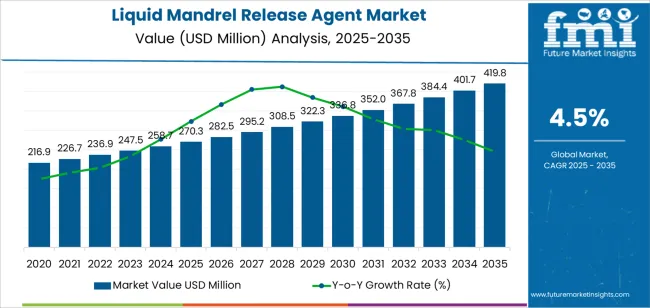
The market demonstrates strong momentum across developed and emerging manufacturing economies, where composite and rubber industries are transitioning from conventional release methods to advanced coating systems that offer superior performance characteristics. Liquid mandrel release agent technology addresses critical manufacturing challenges including mandrel surface protection maintenance in repeated molding applications, part adhesion prevention in complex geometries, and coating consistency across extended production runs.
The automotive sector's shift toward lightweight composite components and complex part configurations creates continued demand for release solutions capable of processing carbon fiber composites, fiberglass materials, and synthetic rubber compounds with minimal surface defects and consistent quality output. Aerospace manufacturers are adopting liquid mandrel release agents for composite component fabrication where surface finish quality directly impacts assembly tolerances and structural performance requirements. The technology's ability to produce clean part separation with excellent surface characteristics reduces secondary cleaning operations and accelerates production workflows.
Industrial composite manufacturers and rubber processing facilities are investing in liquid mandrel release agent systems to enhance competitive positioning through improved productivity metrics and expanded material processing capabilities. The integration of advanced formulation technologies and optimized coating application methods enables these agents to achieve release performance 25-45% better than conventional systems while maintaining mandrel protection characteristics. Initial formulation cost requirements for specialized release agent systems and application technique barriers for optimal coating uniformity may pose challenges to market expansion in cost-sensitive manufacturing segments and regions with limited access to technical training resources.
Between 2025 and 2030, the liquid mandrel release agent market is projected to expand from USD 270.3 million to USD 336.9 million, resulting in a value increase of USD 66.6 million, which represents 44.5% of the total forecast growth for the decade. This phase of development will be shaped by rising demand for composite manufacturing solutions in automotive and aerospace sectors, product innovation in water-based formulation technology and application systems, as well as expanding integration with advanced mandrel processing equipment and automated coating lines. Companies are establishing competitive positions through investment in environmentally-friendly formulation designs, surface-active coating technologies, and strategic market expansion across composite component manufacturing, rubber hose production, and industrial molding applications.
From 2030 to 2035, the market is forecast to grow from USD 336.9 million to USD 419.8 million, adding another USD 82.9 million, which constitutes 55.5% of the overall ten-year expansion. This period is expected to be characterized by the expansion of specialized release agent systems, including advanced bio-based formulations and multi-functional coating configurations tailored for specific substrate types and mandrel material requirements, strategic collaborations between release agent manufacturers and composite equipment builders, and an enhanced focus on environmental compliance and performance optimization. The growing emphasis on eco-conscious manufacturing and process efficiency will drive demand for advanced, high-performance liquid mandrel release agent solutions across diverse composite and rubber processing applications.
| Metric | Value |
|---|---|
| Market Value (2025) | USD 270.3 million |
| Market Forecast Value (2035) | USD 419.8 million |
| Forecast CAGR (2025-2035) | 4.5% |
The liquid mandrel release agent market grows by enabling manufacturers to achieve superior part release and surface quality while reducing production cycle times in composite and rubber processing operations. Manufacturing facilities face mounting pressure to improve production efficiency and component quality, with liquid mandrel release agent systems typically providing 35-55% cycle time reduction over conventional release methods, making these specialized formulations essential for competitive manufacturing operations. The composite and rubber industries' need for clean mandrel separation creates demand for advanced release agent solutions that can prevent adhesion, protect mandrel surfaces, and ensure consistent part quality across diverse material types and production volumes.
Industrial automation initiatives promoting process integration and high-throughput manufacturing drive adoption in composite fabrication, rubber hose production, and industrial molding applications, where release efficiency has a direct impact on production capacity and manufacturing costs. The global shift toward eco-conscious manufacturing practices and environmental compliance accelerates liquid mandrel release agent demand as processing facilities seek coating solutions that minimize volatile organic compound emissions and maximize process safety. Limited awareness of optimal application techniques and higher formulation costs compared to conventional release agents may limit adoption rates among small-scale processors and regions with traditional manufacturing practices and limited technical support infrastructure.
The market is segmented by formulation type, application, and region. By formulation type, the market is divided into solvent-based and water-based. Based on application, the market is categorized into SBR, NBR, EPDM, PVC, and others. Regionally, the market is divided into Asia Pacific, Europe, North America, Latin America, and Middle East & Africa.

The solvent-based segment represents the dominant force in the liquid mandrel release agent market, capturing approximately 58% of total market share in 2025. This advanced category encompasses standard solvent formulations, high-performance variants, and specialized compositions optimized for demanding release applications, delivering efficient coating performance and superior release characteristics in composite and rubber processing operations. The solvent-based segment's market leadership stems from its proven formulation architecture, fast-drying properties, and compatibility with diverse mandrel materials across automotive component manufacturing, aerospace composite fabrication, and industrial rubber molding facilities.
The water-based segment maintains a substantial 42.0% market share, serving manufacturers who require environmentally-friendly release capabilities through low-VOC formulations, reduced environmental impact, and specialized coating properties that comply with stringent emission regulations.
Key advantages driving the solvent-based segment include:
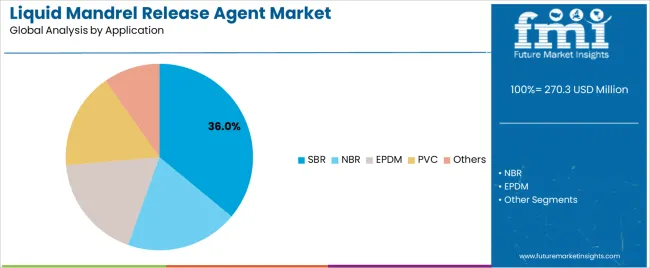
SBR applications dominate the liquid mandrel release agent market with approximately 36.0% market share in 2025, reflecting the extensive adoption of release solutions across styrene-butadiene rubber hose manufacturing, automotive rubber component production, and industrial rubber molding operations. The SBR segment's market leadership is reinforced by widespread implementation in hydraulic hose production (14.0%), industrial hose manufacturing (12.0%), and automotive rubber components (10.0%), which provide essential productivity advantages and quality consistency in high-volume rubber processing environments.
The NBR segment represents 27.0% market share through specialized applications including oil-resistant hose manufacturing (11.0%), automotive sealing systems (9.0%), and industrial gasket production (7.0%). EPDM accounts for 19.0% market share, driven by adoption in weatherproof hose production (8.0%), automotive weather seals (6.0%), and roofing membrane applications (5.0%). PVC constitutes 11.0% market share through wire coating operations (5.0%), profile extrusion (4.0%), and tubing applications (2.0%). Other applications represent 7.0% market share, encompassing specialty rubber processing, composite tube manufacturing, and industrial molding requirements.
Key market dynamics supporting application preferences include:
The market is driven by three concrete demand factors tied to manufacturing efficiency and quality outcomes. First, composite manufacturing expansion creates increasing requirements for efficient release solutions, with global composite materials production exceeding 12 million tons annually in major markets worldwide, requiring reliable liquid mandrel release agent systems for carbon fiber components, fiberglass tubing, and composite structural parts fabrication. Second, rubber industry growth and automation drive adoption of advanced release technology, with liquid mandrel release agents improving production throughput by 30-45% while reducing surface defects in rubber hose and automotive component manufacturing used extensively in transportation and industrial equipment sectors. Third, environmental regulations and green initiatives accelerate deployment of low-VOC formulations, with liquid mandrel release agents integrating seamlessly into green manufacturing programs and enabling compliance with emission standards in composite and rubber processing facilities.
Market restraints include formulation cost barriers affecting small-scale processors and cost-sensitive manufacturing operations, particularly where conventional release methods remain adequate for less demanding applications and where material budgets constrain adoption of premium release agent systems. Application technique requirements for optimal coating uniformity pose adoption challenges for facilities lacking experienced processing personnel, as liquid mandrel release agent performance depends heavily on proper dilution ratios, application methods, and curing conditions that vary significantly across substrate types and production environments. Limited availability of technical support infrastructure in emerging manufacturing markets creates additional barriers, as processing facilities require specialized training in formulation selection, application procedures, and troubleshooting methods to achieve target release performance levels.
Key trends indicate accelerated adoption in Asian manufacturing hubs, particularly China and India, where composite component production and rubber manufacturing capabilities are expanding rapidly through government industrialization programs and foreign direct investment in processing infrastructure. Technology advancement trends toward bio-based formulations with renewable content, nano-engineered coatings for enhanced release performance, and automated application systems enabling precise coating control are driving next-generation product development. The market thesis could face disruption if thermoplastic composite technologies achieve breakthrough capabilities in eliminating mandrel requirements through innovative manufacturing processes, potentially reducing demand for conventional mandrel release operations in specific application segments.
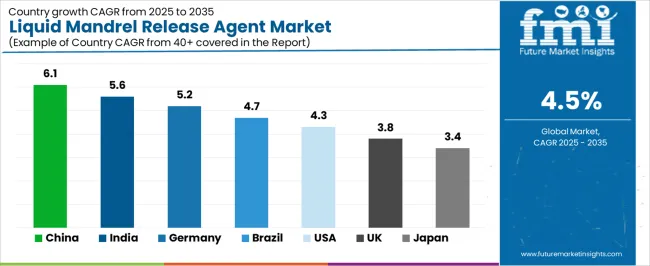
| Country | CAGR (2025-2035) |
|---|---|
| China | 6.1% |
| India | 5.6% |
| Germany | 5.2% |
| Brazil | 4.7% |
| USA | 4.3% |
| UK | 3.8% |
| Japan | 3.4% |
The liquid mandrel release agent market is gaining momentum worldwide, with China taking the lead thanks to aggressive composite manufacturing expansion and industrial modernization programs. Close behind, India benefits from growing rubber industry investment and government manufacturing initiatives, positioning itself as a strategic growth hub in the Asia-Pacific region. Brazil shows strong advancement, where expanding automotive component operations and rubber processing infrastructure development strengthen its role in South American manufacturing supply chains. The USA demonstrates robust growth through advanced composite technology initiatives and aerospace sector investment, signaling continued adoption in precision manufacturing applications. Meanwhile, Japan stands out for its precision processing expertise and advanced manufacturing technology integration, while UK and Germany continue to record consistent progress driven by composite engineering centers and industrial rubber manufacturing. Together, China and India anchor the global expansion story, while established markets build stability and technology leadership into the market's growth path.
The report covers an in-depth analysis of 40+ countries; with top-performing countries highlighted below.
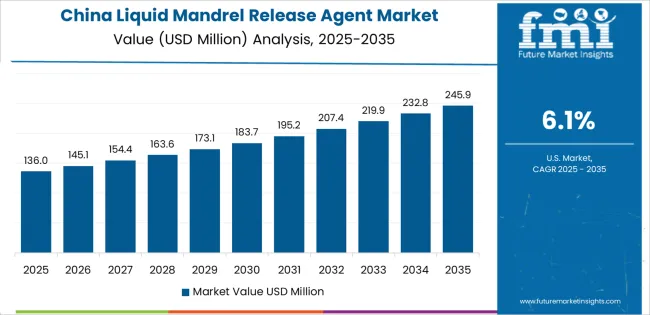
China demonstrates the strongest growth potential in the Liquid Mandrel Release Agent Market with a CAGR of 6.1% through 2035. The country's leadership position stems from comprehensive composite manufacturing expansion, intensive rubber industry development programs, and aggressive industrial modernization targets driving adoption of advanced release agent technologies. Growth is concentrated in major manufacturing regions, including Guangdong, Jiangsu, Zhejiang, and Shandong, where composite component manufacturers, rubber processors, and industrial molding facilities are implementing liquid mandrel release agent systems for productivity enhancement and quality improvement. Distribution channels through chemical distributors, specialty coating suppliers, and direct manufacturer relationships expand deployment across automotive component clusters, composite fabrication bases, and rubber processing centers. The country's Made in China 2025 initiative provides policy support for advanced manufacturing chemical adoption, including subsidies for process chemical implementation and manufacturing technology upgrades.
Key market factors:
In the National Capital Region, Maharashtra, Tamil Nadu, and Gujarat industrial zones, the adoption of liquid mandrel release agent systems is accelerating across rubber hose manufacturing, composite component fabrication facilities, and industrial molding operations, driven by Make in India initiatives and increasing focus on manufacturing competitiveness. The market demonstrates strong growth momentum with a CAGR of 5.6% through 2035, linked to comprehensive rubber sector expansion and increasing investment in composite manufacturing capabilities. Indian manufacturers are implementing liquid mandrel release agent technology and advanced coating processes to improve production efficiency while meeting stringent quality requirements in automotive and industrial supply chains serving domestic and export markets. The country's National Manufacturing Policy creates continued demand for advanced process chemicals, while increasing emphasis on industrial automation drives adoption of release agent systems that enhance manufacturing productivity.
Advanced manufacturing sector in Germany demonstrates sophisticated implementation of liquid mandrel release agent systems, with documented case studies showing 30-40% cycle time reduction in composite component molding operations through optimized release strategies. The country's manufacturing infrastructure in major industrial regions, including Bavaria, Baden-Württemberg, North Rhine-Westphalia, and Lower Saxony, showcases integration of release agent technologies with existing composite processing systems, leveraging expertise in automotive engineering and aerospace component production. German manufacturers emphasize quality standards and process optimization, creating demand for reliable liquid mandrel release agent solutions that support productivity commitments and stringent surface quality requirements. The market maintains strong growth through focus on Industry 4.0 integration and manufacturing excellence, with a CAGR of 5.2% through 2035.
Key development areas:
The Brazilian market leads in Latin American liquid mandrel release agent adoption based on expanding automotive manufacturing operations and growing rubber processing infrastructure in major industrial centers. The country shows solid potential with a CAGR of 4.7% through 2035, driven by automotive sector investment and increasing domestic demand for rubber hose and composite components across transportation equipment, agricultural machinery, and industrial sectors. Brazilian manufacturers are adopting liquid mandrel release agent technology for compliance with automotive industry quality standards, particularly in rubber hose production requiring consistent release performance and in composite part fabrication where surface quality impacts component economics. Technology deployment channels through chemical distributors, coating representatives, and technical service programs expand coverage across automotive supply chains and rubber processing facilities.
Leading market segments:
The USA market leads in advanced liquid mandrel release agent applications based on integration with sophisticated composite processing systems and comprehensive manufacturing automation platforms for enhanced production efficiency. The country shows solid potential with a CAGR of 4.3% through 2035, driven by aerospace manufacturing expansion and increasing adoption of advanced composite technologies across automotive, defense, and industrial equipment production sectors. American manufacturers are implementing liquid mandrel release agent systems for high-precision molding requirements, particularly in aerospace composite components demanding excellent surface finish and in automotive parts production where cycle time reduction directly impacts manufacturing economics. Technology deployment channels through chemical distributors, coating specialists, and direct manufacturer relationships expand coverage across diverse composite and rubber operations.
Leading market segments:
The UK market demonstrates consistent implementation focused on composite component manufacturing and rubber hose production, with documented integration of liquid mandrel release agent systems achieving 25-35% productivity improvements in molding operations. The country maintains steady growth momentum with a CAGR of 3.8% through 2035, driven by automotive manufacturing presence and aerospace industry requirements for advanced release capabilities in composite materials. Major industrial regions, including West Midlands, North West England, and South Wales, showcase deployment of release agent technologies that integrate with existing manufacturing infrastructure and support quality requirements in automotive and aerospace supply chains.
Key market characteristics:
Liquid mandrel release agent market in Japan demonstrates sophisticated implementation focused on rubber component production and composite manufacturing, with documented integration of advanced release systems achieving 28-32% cycle time reduction in precision molding operations. The country maintains steady growth momentum with a CAGR of 3.4% through 2035, driven by manufacturing excellence culture and emphasis on process optimization principles aligned with lean manufacturing philosophies. Major industrial regions, including Aichi, Kanagawa, Osaka, and Shizuoka, showcase advanced deployment of release agent technologies that integrate seamlessly with automated processing lines and comprehensive quality control systems.
Key market characteristics:

The liquid mandrel release agent market in Europe is projected to grow from USD 78.3 million in 2025 to USD 121.6 million by 2035, registering a CAGR of 4.5% over the forecast period. Germany is expected to maintain its leadership position with a 30.7% market share in 2025, declining slightly to 30.2% by 2035, supported by its extensive composite manufacturing infrastructure and major industrial centers, including Bavaria, Baden-Württemberg, and North Rhine-Westphalia production regions.
France follows with a 18.9% share in 2025, projected to reach 19.3% by 2035, driven by comprehensive automotive component production and aerospace composite manufacturing programs in major industrial regions. The United Kingdom holds a 15.6% share in 2025, expected to reach 15.9% by 2035 through automotive engineering centers and composite fabrication facilities. Italy commands a 13.4% share in both 2025 and 2035, backed by rubber component production and automotive manufacturing. Spain accounts for 9.8% in 2025, rising to 10.1% by 2035 on automotive assembly operations and rubber processing sector growth. The Rest of Europe region is anticipated to hold 11.6% in 2025, expanding to 12.1% by 2035, attributed to increasing liquid mandrel release agent adoption in Nordic countries and emerging Central & Eastern European composite manufacturing operations.
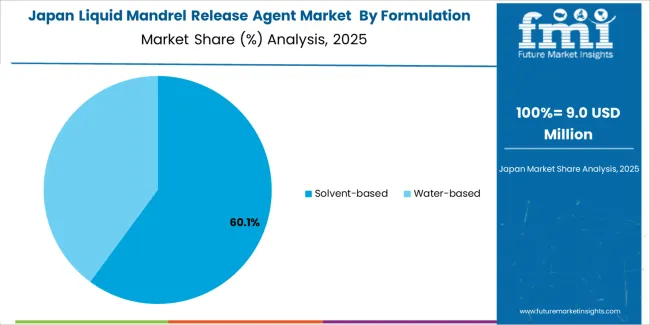
The Japanese liquid mandrel release agent market demonstrates a mature and quality-focused landscape, characterized by sophisticated integration of solvent-based release systems with existing rubber processing infrastructure across automotive component production, industrial hose manufacturing, and composite fabrication operations. Japan's emphasis on manufacturing excellence and process optimization drives demand for release agents that support quality commitments and productivity targets in competitive manufacturing environments. The market benefits from strong partnerships between international chemical providers and domestic industrial distributors including major trading companies, creating comprehensive service ecosystems that prioritize technical support and application engineering programs. Industrial centers in Aichi, Kanagawa, Osaka, and other major manufacturing areas showcase advanced processing implementations where liquid mandrel release agent systems achieve 97% release success rates through optimized application parameters and comprehensive process control systems.

The South Korean liquid mandrel release agent market is characterized by growing international technology provider presence, with companies maintaining significant positions through comprehensive technical support and application engineering capabilities for rubber hose manufacturing and composite component production applications. The market demonstrates increasing emphasis on manufacturing automation and productivity enhancement, as Korean manufacturers increasingly demand advanced release solutions that integrate with domestic processing infrastructure and sophisticated production management systems deployed across major industrial complexes. Regional chemical distributors are gaining market share through strategic partnerships with international manufacturers, offering specialized services including technical training programs and application-specific coating solutions for automotive and industrial rubber production operations. The competitive landscape shows increasing collaboration between multinational chemical companies and Korean industrial specialists, creating hybrid service models that combine international product development expertise with local technical support capabilities and rapid response systems.
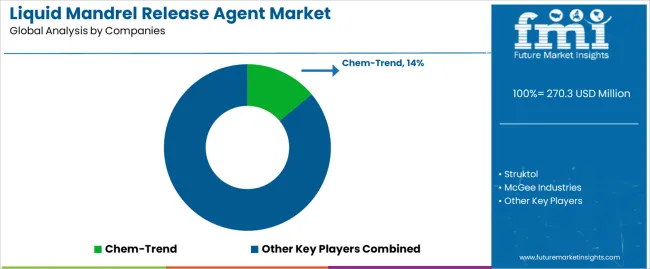
The liquid mandrel release agent market features approximately 20-25 meaningful players with moderate fragmentation, where the top three companies control roughly 34-38% of global market share through established distribution networks and comprehensive product portfolios. Competition centers on release performance consistency, formulation reliability, and technical support capabilities rather than price competition alone. Chem-Trend leads with approximately 14.0% market share through its comprehensive specialty chemical solutions portfolio and global manufacturing presence.
Market leaders include Chem-Trend, Struktol, and Evonik Industries, which maintain competitive advantages through global distribution infrastructure, advanced formulation technology, and deep expertise in application engineering across multiple industrial sectors, creating trust and reliability advantages with composite manufacturers and rubber processing operations. These companies leverage research and development capabilities in coating chemistry optimization and ongoing technical support relationships to defend market positions while expanding into emerging manufacturing markets and specialized application segments.
Challengers encompass McGee Industries and WN SHAW, which compete through specialized product offerings and strong regional presence in key manufacturing markets. Product specialists, including Münch Chemie, Lion Specialty Chemicals, and Maverix Solutions, focus on specific formulation types or regional markets, offering differentiated capabilities in custom coating solutions, rapid delivery services, and competitive pricing structures.
Regional players and emerging chemical manufacturers create competitive pressure through localized production advantages and responsive technical support capabilities, particularly in high-growth markets including China and India, where proximity to composite and rubber processing clusters provides advantages in technical support responsiveness and customer relationships. Market dynamics favor companies that combine proven release performance with comprehensive application engineering offerings that address the complete manufacturing cycle from formulation selection through process optimization and quality assurance.
Liquid mandrel release agents represent advanced chemical solutions that enable manufacturers to achieve 35-55% cycle time reduction compared to conventional release methods, delivering superior part separation and surface quality with enhanced mandrel protection and coating uniformity in demanding composite and rubber processing applications. With the market projected to grow from USD 270.3 million in 2025 to USD 419.8 million by 2035 at a 4.5% CAGR, these specialized coating formulations offer compelling advantages - productivity enhancement, quality improvement, and mandrel protection - making them essential for SBR applications (36.0% market share), NBR operations (27.0% share), and manufacturing facilities seeking alternatives to conventional release methods that compromise surface quality through inconsistent coating and poor mandrel protection. Scaling market adoption and technology deployment requires coordinated action across industrial policy, manufacturing infrastructure development, chemical manufacturers, processing facilities, and industrial chemical investment capital.
How Governments Could Spur Local Production and Adoption?
How Industry Bodies Could Support Market Development?
How OEMs and Technology Players Could Strengthen the Ecosystem?
How Suppliers Could Navigate the Shift?
How Investors and Financial Enablers Could Unlock Value?
| Item | Value |
|---|---|
| Quantitative Units | USD 270.3 million |
| Formulation Type | Solvent-based, Water-based |
| Application | SBR, NBR, EPDM, PVC, Others |
| Regions Covered | Asia Pacific, Europe, North America, Latin America, Middle East & Africa |
| Country Covered | China, India, Germany, Brazil, USA, UK, Japan, and 40+ countries |
| Key Companies Profiled | Chem-Trend, Struktol, McGee Industries, WN SHAW, Evonik Industries, Lion Specialty Chemicals, Lotrèc AB, Münch Chemie, Maverix Solutions, Shanghai HD Chemical, Dongguan Antai Fine Chemical, Caldic, APV Engineered Coatings |
| Additional Attributes | Dollar sales by formulation type and application categories, regional adoption trends across Asia Pacific, Europe, and North America, competitive landscape with specialty chemical manufacturers and distribution networks, manufacturing facility requirements and specifications, integration with mandrel processing systems and automated coating platforms, innovations in formulation chemistry and application systems, and development of specialized release solutions with enhanced environmental compliance and performance capabilities. |
The global liquid mandrel release agent market is estimated to be valued at USD 270.3 million in 2025.
The market size for the liquid mandrel release agent market is projected to reach USD 419.8 million by 2035.
The liquid mandrel release agent market is expected to grow at a 4.5% CAGR between 2025 and 2035.
The key product types in liquid mandrel release agent market are solvent-based and water-based.
In terms of application, sbr segment to command 36.0% share in the liquid mandrel release agent market in 2025.






Full Research Suite comprises of:
Market outlook & trends analysis
Interviews & case studies
Strategic recommendations
Vendor profiles & capabilities analysis
5-year forecasts
8 regions and 60+ country-level data splits
Market segment data splits
12 months of continuous data updates
DELIVERED AS:
PDF EXCEL ONLINE
Liquid Filling Machine Market Size and Share Forecast Outlook 2025 to 2035
Liquid Oxygen Generator Market Size and Share Forecast Outlook 2025 to 2035
Liquid Packaging Bag Market Size and Share Forecast Outlook 2025 to 2035
Liquid Carton Packaging Market Size and Share Forecast Outlook 2025 to 2035
Liquid Desiccant Natural Gas Dehydration Unit Market Size and Share Forecast Outlook 2025 to 2035
Liquid Filled Pressure Gauges Market Size and Share Forecast Outlook 2025 to 2035
Liquid Filtration Market Size and Share Forecast Outlook 2025 to 2035
Liquid Packaging Board Market Size and Share Forecast Outlook 2025 to 2035
Liquid Filled Capsule Market Size and Share Forecast Outlook 2025 to 2035
Liquid Density Meters Market Size and Share Forecast Outlook 2025 to 2035
Liquid Cold Plates Market Size and Share Forecast Outlook 2025 to 2035
Liquid Crystal Polymers Market Size and Share Forecast Outlook 2025 to 2035
Liquid Hydrogen Market Size and Share Forecast Outlook 2025 to 2035
Liquid Cooled Home Standby Gensets Market Size and Share Forecast Outlook 2025 to 2035
Liquid Nitrogen Purge Systems Market Size and Share Forecast Outlook 2025 to 2035
Liquid Chromatography Systems Market Size and Share Forecast Outlook 2025 to 2035
Liquid Armor Materials Market Size and Share Forecast Outlook 2025 to 2035
Liquid Synthetic Rubber Market Size and Share Forecast Outlook 2025 to 2035
Liquid Crystal Polymer (LCP) Market Size and Share Forecast Outlook 2025 to 2035
Liquid Smoke Market Analysis - Size, Share, and Forecast Outlook 2025 to 2035

Thank you!
You will receive an email from our Business Development Manager. Please be sure to check your SPAM/JUNK folder too.
Chat With
MaRIA